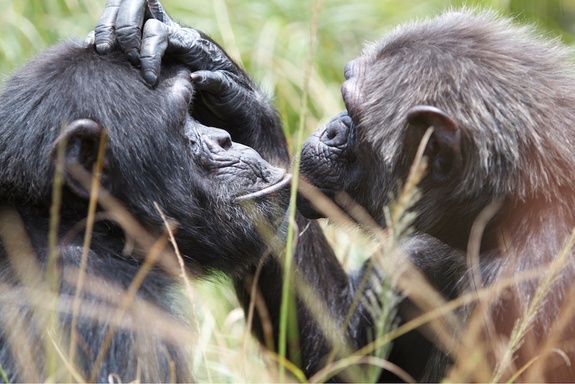Chimps Can Get Inside Others' Heads Just Like Humans

Chimps know what tools others need to get work done and can help them select the right instruments, suggesting the apes have the ability to understand the minds of others, scientists find.
The capability to consider the goals and share the perspective of others, known as "theory of mind," has long been considered unique to humans. This aptitude may be why humans cooperate in an altruistic, "prosocial" manner to develop societies.
"Humans sometimes help others just upon witnessing others' predicaments — donations for tsunami and earthquake victims are a typical case," said researcher Shinya Yamamoto, a primatologist at Kyoto University in Japan.
To see whether our closest living relatives, chimpanzees, possess theory of mind — and perhaps learn how it evolved — scientists tested how well the apes could understand the goals of other chimps. [8 Humanlike Behaviors of Primates]
Researchers presented five chimpanzees with seven tools on a tray: a stick, a straw, a hose, a chain, a rope, a brush and a belt. These apes witnessed other chimps struggling with tasks where they could receive a reward of juice, and could potentially help them by handing them a tool. One task required a stick to get an otherwise out-of-reach juice bottle; another depended on a straw to drink juice through a hole. The apes used in these experiments were all mother-child pairs, enhancing the chances they would want to provide aid — each chimp in these pairs took turns being either a potential helper or recipient.
The potential helpers offered either a stick or a straw for the juice tasks about 80 percent to 100 percent of the time. This suggested they understood the needs of the potential recipients. One chimp, Pan, showed an unusual preference to offer the brush first, regardless of the task at hand, but once it was removed, she typically picked the tool her offspring needed.
"Chimpanzees as well as humans help others without any direct benefit for themselves, and their helping fits the others' needs," Yamamoto told LiveScience.
Get the world’s most fascinating discoveries delivered straight to your inbox.
"Our study suggests that chimpanzees understood others' goal, but it might be different from humanlike 'mind-reading,'" Yamamoto added. Human understanding of others is augmented with language and gestures not seen with the chimps.
Amusingly, "in our experiments, helper chimpanzees just helped, and the recipient monopolized the juice — they never share the juice," Yamamoto said. "When the helper chimpanzee reach[ed] out his or her arm toward the juice in the recipient's hand, the juice owner drank up the juice and handed the empty bottle to his or her benefactor. It was somewhat embarrassing for me."
"But finally I realized that these are chimpanzees, and that they live in line with their own rules, not with human rules," Yamamoto said. "After the experiments, the helper and the recipient got together peacefully without any obvious conflict."
Similar experiments could help test for theory of mind in other animals, such as bonobos, whose relationship to humans is as close as that of common chimpanzees. "Comparative studies with bonobos will also deepen our understanding of the evolution of prosociality and its mechanisms," Yamamoto said.
Yamamoto and his colleagues Tatyana Humle and Masayuki Tanaka detailed their findings online Feb. 6 in the Proceedings of the National Academy of Sciences.



